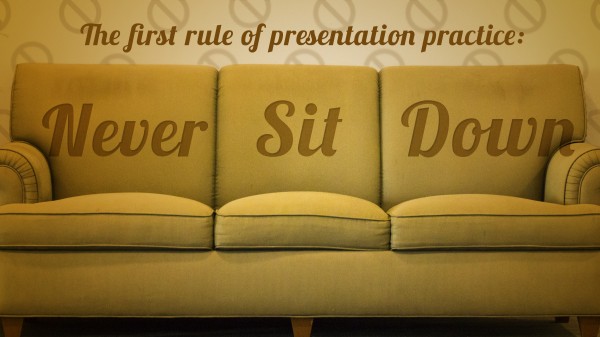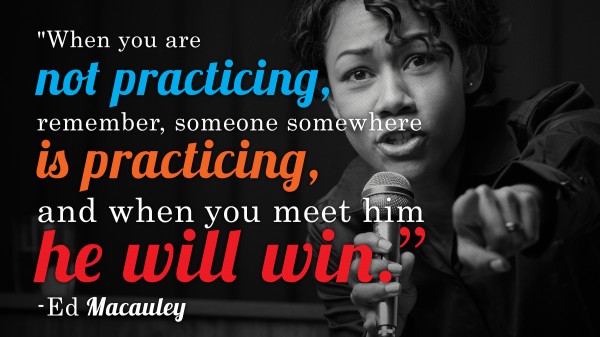Forget all of the bologna you’ve heard about adults being unable to learn new skills because the brain “hardens” at 25; science has proven otherwise. No matter how old you are, you can learn to become a masterful presenter through deliberate practice. It’s how the best speakers in history have risen to power, made fortunes, and stayed relevant long after their time. Consider this quote from Mark Twain on the work involved for an “impromptu” speech:
“The best and most telling speech is not the actual impromptu one, but the counterfeit of it … that speech is most worth listening to which has been carefully prepared in private and tried on a plaster cast, or an empty chair, or any other appreciative object that will keep quiet, until the speaker has got his matter and his delivery limbered up so that they will seem impromptu to an audience.” – Mark Twain’s speech in New York City, 31 March 1885
Do you want to be rich and famous like Mark Twain? The secret is practice.
The Science Behind It
Our brains are like incredibly powerful trains travelling to Success Town; all we need to do is ensure they are well-oiled, fueled properly, and put on the right track. When we accomplish a task, our brains coordinate the actions of our motor functions, verbal skills, and sensory processing. This process is called “myelination,” which increases the strength of our nerve impulses in the brain. It’s like a charged up super fuel, making the train speed ever nearer to Success Town.
When we practice, myelination triggers the electrical pattern that causes us to successfully execute the action. It’s the brain’s way of saying, “oh, I’ve seen this before, I can do it a bazillion times faster than last time.” In a study of speed chess players, those who clocked in more game time were more likely to recognize patterns on the board and win.
In order to see positive results, studies have also shown that your brain must engage in “mindful” practice. This means avoiding doing the same thing over and over on autopilot without actively trying different techniques and slowly working through problems. “Instead of mindless trial and error, it is an active and thoughtful process of hypothesis testing where we relentlessly seek solutions to clearly defined problems.” – Noa Kageyama
All aboard the train to Success Town!
What to Practice
There are three areas to practice in order to become a masterful presenter:
Body Language – This is an essential part of how you appear to your audience on a psychological level. Body language encompasses your hand gestures, movements, posture, and facial expressions; strengthening this can be the difference between appearing like a confident go-getter or a meek no-getter. Check out our post on different ways to improve bad body language.
Vocal Tone – If you make a vocal misstep, the results are immediate. Practicing this means managing speed, volume, and inflection to ensure that you are heard clearly and powerfully. Luckily for all, we also have a more detailed post on what you should aim for when practicing.
Content – When most people think of “practicing,” they incorrectly think of memorization. Familiarizing yourself with your content means that you know it backwards and forwards, but still have the ease of a natural, non-robotic presentation. Engage yourself with the content, don’t just mindlessly drill your main points and read directly off your slides during your presentation.
“Preparation will carry you through, provided you understand the logic and rehearse the format. When presentation time comes, trust you know your stuff, and that details will be there to pull from as you talk. If done correctly, no two presentations will ever be alike. Be in the moment, delivering it fresh and new, every time.” – Barbara Niven
The best way to assess which areas you are weakest is to record yourself running through the content of your presentation and then reviewing the video for any weak spots. Do your arms flail when your tone is neutral? Do you struggle to remember main points? Take notes as you watch and give yourself a diver’s score when it’s over. Once you’ve thoroughly assessed, you are ready to start the hard work: actual practice.
How to Practice
“Mr. Lincoln thought his speeches out on his feet walking in the streets: he penned them in small scraps — sentences, & paragraphs, depositing them in his hat for safety. When fully finished, he would recopy, and could always repeat easily by heart — so well thoughted, shotted, and matured were they.” – William H. Herndon lecture, January 24, 1866
Begin by setting the stage for yourself; you want to simulate the conditions of your presentation as closely as possible. Olympic swimmers don’t practice in kiddie pools, and nor should you practice sitting in a recliner with a box of cookies. Practice with the equipment you will use, as well as the presentation you have created. Once you’ve set the stage as best as you can, consider trying:
Standing Tall – Never sit down when you practice, let yourself become familiar with standing (not cowering) as you speak.
Enlist a Friend – If you can possibly enlist a stray friend to watch one of your practices, do so. If not, consider recording each practice or using a mirror to gauge your body language. Need even more of a reason to pester a friend? “Research has established that fast, simple feedback is almost always more effective at shaping behavior than is a more comprehensive response well after the fact.” (Source)
Chunk Your Message – If the length of your presentation is daunting, work on one piece at a time. You may also try elaborating on a single point from existing knowledge. Break your presentation into sections, break your sections into sentences, and then break those sentences into chunks.
Try “Opposite Day” – If you’ve watched a recording of your presentation and notice a few weak spots, locate where those places are and then try out an extreme (even silly) version of “opposite day.” For example, if you are talking too quickly, take time to talk in slow-motion. It will help keep you mindful and more active during your practice.
Background Noise – In another effort to recreate the presentation setting, you may consider playing music in the background to help enhance your focus.
Get Rid of Your “Um’s” – We’ve done a bit of research on the subject; word filler can be reduced or avoided entirely with the right kind of work. If you’ve noticed a lot of “like’s” “um’s” and “ah’s” plaguing your delivery, we have a great resource for you.
How Often to Practice
“Some people fear that too much rehearsal undermines spontaneity and authenticity. Actors know the opposite to be true. Having your material internalized actually frees you to live in the moment.” – Rob Biesenbach
We don’t recommend cramming all of your presentation practice the night before your event. In fact, a study conducted by the University of Sheffield concluded that: “more practice is better, but if you space it out instead of doing it all at once then you improve.” Furthermore “those willing to experiment and learn from their mistakes at the beginning tend to perform better in the long-run.”
Maybe you are searching for a concrete amount of time to rehearse, but there really is no magic number. According to Forbes: “How much should you rehearse? A lot. Stage actors often get up to 6 weeks, 5 or 6 days per week, 8 – 10 hours per day, to rehearse. That’s how you end up looking natural, assured, and authoritative. Not by winging it.”
You might run through a presentation by relying on memorization and mindless repetition a thousand times and not accomplish the same results as someone who thoughtfully rehearsed 5 times. There is no magic number, unfortunately. If you space out your practice sessions long before the event and avoid cramming the night before, science has proven that your performance will be better.
Put In The Work, We Beg You
Studies have revealed that 91% of audience members admit to daydreaming during a business presentation. If you could snap your audience out of a sleepy stupor, grab their attention, and become the most memorable speaker they’ve ever seen, you would. Surprise! It’s possible through diligent, sometimes frustrating, and time-consuming practice.
Question: What is your presentation practice game plan?



